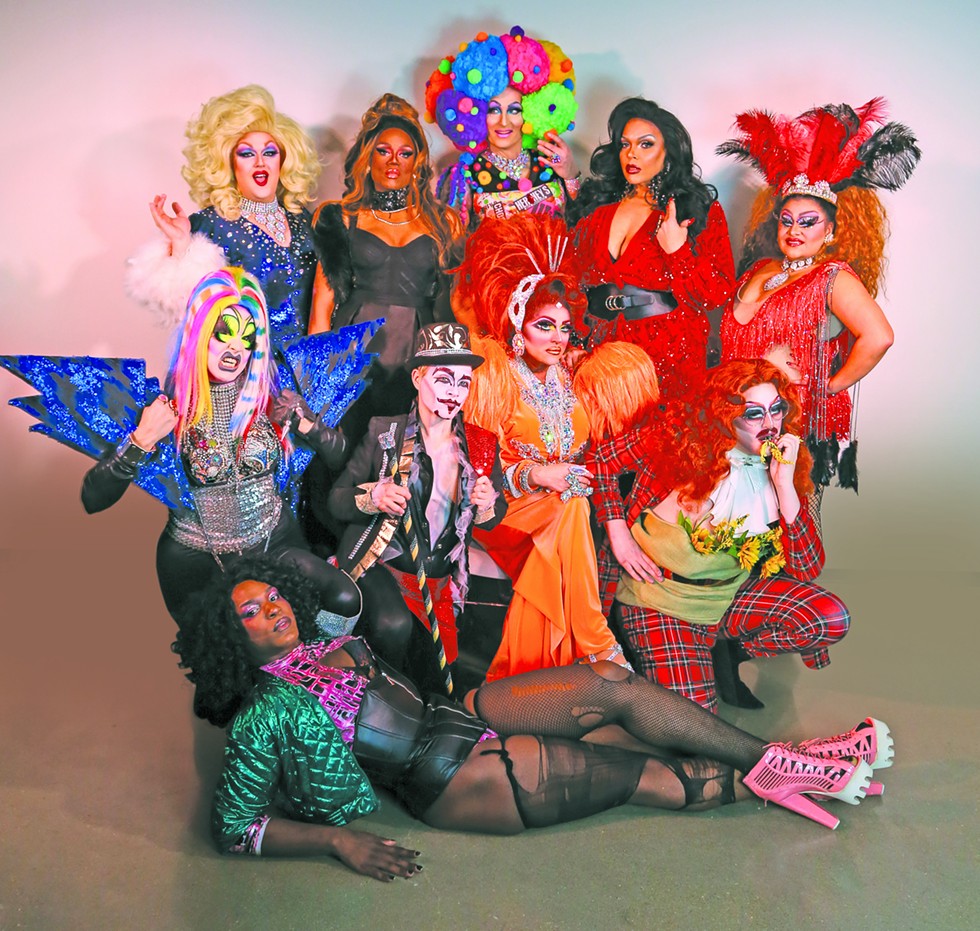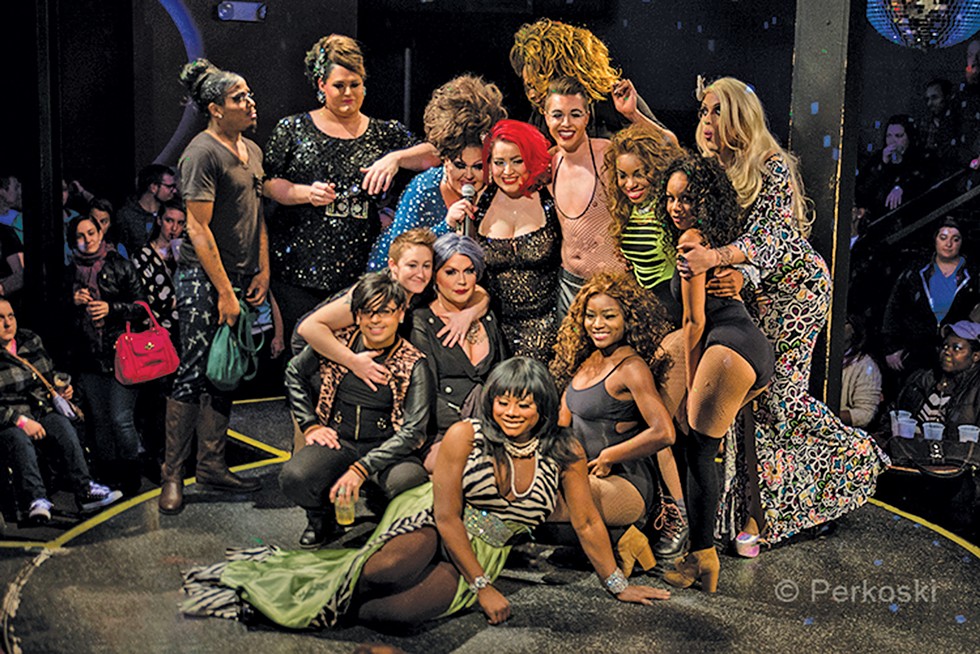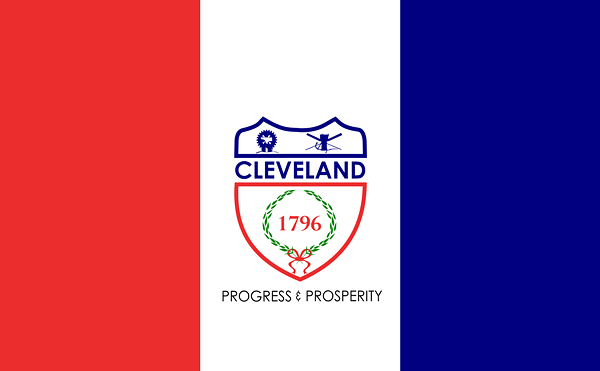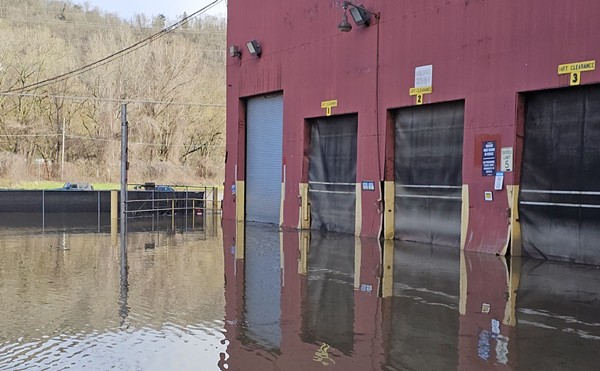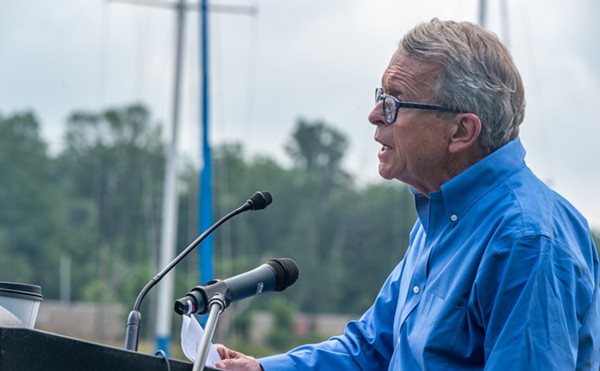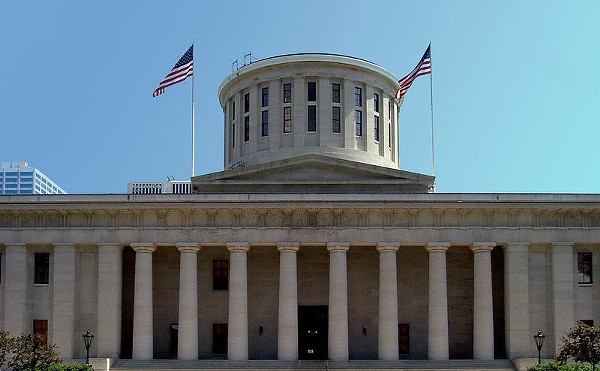"Drag comes in and out of favor of the mainstream," says Dr. Lady J Martinez, a performer with a decade of experience and a Doctor of Philosophy from Case Western Reserve University in musicology with a focus on drag history.
Cleveland's enjoying a bit of a boom period these days, the scene a melting pot of styles playing out across venues traditional and, increasingly, nontraditional.
The evolution in styles, and the continued spread to venues outside of gay bars, are both reflections of and reactions to drag's place in the mainstream in the past decade (which is very much in) and the changes the 2010s brought locally ... for better, and from the perspective of some of the community, for worse.
While RuPaul's Drag Race, and then Dragula, a sort of anti-Drag Race show, and recently the campy Camp Wannakiki, all made the drag revolution a pop culture media force, local performers were dealing with the closure of Bounce, the beloved and legendary near-westside gay bar and club that served as ground zero for drag in Cleveland from 2000 to 2014, when it closed — and again from the summer of 2015, when it reopened under new ownership, until it closed again in 2017.
"Simply put, Bounce was home," says Donnie Waste, a former member of Cleveland Kings and Queens. "We formed friendships there with the queens we idolized like Kari Nickels, Kiarra Cartier Fontaine, Andria Michaels, Blossom, Athena Ghost and Mandy Merlot."
Merlot was the show director at Bounce from 2006 until 2015, and remembers the era fondly.
"You know, it was kind of like a family," Merlot says. "All the seasoned queens were taking younger ones under their wings. Back then, we were all really respectful about our history and culture. And Bounce was like the fucking place to be. It had so much energy and it was so exciting to have a place like that in Cleveland that included everyone. When it closed, it was the end of an era. There wasn't another venue to hold the amount of people that were there, let alone the cast and budget we had."
It was also the first place that many future performers saw drag at all and inspired them.
Donnie Waste remembers going in the summer of 2016.
"I remember thinking, 'I can do that.'"
Bounce was also focused on diverse programming, including shows from BPOC queens, kings, AFAB queens and burlesque all in the same room with people from all creeds, races, body types and backgrounds.
It was also unique in that it was a showroom bar, and on Friday and Saturday nights it was the place to catch legendary Cleveland drag entertainers like Brionna Brooks, Danyel Vazquez, Madison Phillips, Terri Williams, Miko Chanel, Shari Turner, Akashia, Donnie Waste and Erica Martinez.
Martinez says that the peak era from the late 1980s and into the 2000s started with Uncle Vinnie's la Cabaret, which opened in 1970 and closed in 1993. Drag was an underground scene before then, and in some ways after, though it traced its origins back to Shakespeare and gender-bend parties in the 1920s. The internationally known Jewel Box Revue, starring Cleveland local Lynne Carter, who toured with the revue from the 1930s to 1960s, was an exception in many ways. Locally, progress was slower.
"Vinnie's paved the way for entertainment for the LGBTQ+ community with five days of shows a week," she says.
For those three decades or so after Vinnie's opened, Cleveland was home to 25-plus bars that were part of the LGBTQ+ community.
There was Twiggy's, Traxx, The Grid, Legends in Lakewood, Club Visions on West Sixth, Deco (now Now That's Class), Numbers Nightclub, Memoirs Lounge, Mean Bull and The Leather Stallion, to name just a few.
It was in those venues you could find Big Mama, who started performing in 1964 along with Diana Soul, both of whom were instrumental in the creation of Miss Gay Black Ohio and the Living Color Award. Not every club was accessible to performers of color, so they created spaces for themselves and awards to uplift the community. Big Mama used to share with people the frequent discrimination she faced around the city from show directors who didn't want to book black performers.
Race is still very much central to the drag scene discussion today. While some point to the closure of Bounce and its inclusive booking as a seismic event in that regard, it would still be an issue even if Bounce were still around.
"The Cleveland drag scene can be summed up as a big contradiction," says Kimmy Katarja, who's been performing for three years. "It wants nuance, it wants racially inclusive trans-affirming shows that are art based, but then contradicts itself by putting cis white queens to the front. The first people you saw on screen were cis white males/females. When it comes to entertainment, there needs to be more acceptance for performers of color on stage. You can see lineups with one black drag queen or a white-passing queen. Drag is definitely white-washed."
Other performers expressed similar feelings but said there's been progress in recent years.
"Although we still have a ways to go with acceptance, 'diverse' is the first word that comes to mind when you talk about the scene," says Dakota Cox, who's been performing for three years in Northeast Ohio. "I will say I hope I've helped shed more light on POC here — there's not many of us. Visibility will help newcomers have confidence to step on the stage."
Since Bounce, there's also been an evolution in queer representation on stage and in the audience across the scene.
"Growing up in the LGBTQI community in the 1990s, you could either go to a gay bar or a lesbian bar and the two seldom mixed," says Collin Lingus, who performed from 2005 to 2015. "When Bounce opened, it felt like the community came together and drag was the center of it. I feel like I was able to bring awareness to drag kinging as a performance art during that era."
Carly Uninemclite has seen that evolution come to what the current scene looks like. "I think what's changed the most is the amount of and the kind of queer representation we are seeing. We are slowly getting to the point where more people of different queer identities are feeling safe to talk about their experiences and their identity and how that is tied to their performance. Before, in Cleveland, it was hard to openly talk about queerness beyond just being gay."
Rhett Corvette, a member of the Cleveland Kings Action Pack drag collective, agrees: "I've noticed that the drag scene is beginning to cater to all queer identities. Where audiences used to be made up of mostly gay men, I now notice the audiences are more diverse. The crowds for CKAP include lots of queer women and nonbinary folks. I'm glad that gender performance is becoming a more inclusive art form in Cleveland because people feel they are being represented."
As for the broadened audience spectrum, some of that can be attributed to the fact as gay bars have closed — a trend that tracks from Cleveland across the country — drag started popping up and being welcomed outside of those traditionally safe spaces. That, along with some well-known issues with management and operations, might have also helped spell the end for Bounce. When it closed, general manager Stephen Mayse told Scene, "I feel what with everybody being welcome at every bar, it opens up a world of other places to go. You no longer have to go to just the gay bars. Drag queens are performing at regular bars. I do feel like that was part of the problem."
Still, when Bounce closed, there was a time when the scene felt stalled. Performers took it upon themselves to find new venues and avenues.
"Audiences don't disappear overnight; people don't stop caring about it overnight," says Lady J Martinez, who's been performing for 10 years. "They did not know where to follow us, so we needed to reinvent the wheel and we needed to move out of familiar venues and it was all about location, location, location. We became a full vaudeville show, we become chameleons from punk bars to fancy restaurants. We found a way to become resilient."
And resilient they were.
"Having fewer LGBTQ+ spaces has impacted the frequency of drag performance; however, it has forced those still performing to find alternative spaces to house regular events highlighting drag," says Donnie Waste. "This brings more mainstream appeal to the art of drag and offers greater accessibility to those who may not wander into one of our few remaining safe spaces."
Which is why Cleveland saw the rise of events like the Cleveland Drag Showcase & Queens of the 9 crafted by Veranda L'Ni, who has been a generous and critical person in the scene for years, including running Drag Bingo to raise thousands of dollars for local non-profits. Other events include Black Mass at the Five O'Clock Lounge, GlamGore at the Grog Shop, Drag Bingo at Music Box, Delusional Divas of Drag at Pickwick, the Gag and Drag Brunch at the Winchester, and Fembot at the Chamber. As Samantha Echo says of many of those venues, they "were never queer places until we all set out to make it so."
For former performers and those who have been around for decades, this is both invigorating and different.
"It's a double-edged sword," says Mandy Merlot. "We want to be accepted and we are seeing more and more inclusion in regular bars, so the needs of a gay bar are not always there, but we also are not 100-percent accepted and we still have fear and it's still nice to be in spaces where we don't have to worry."
"Now that drag has adjusted again and it's now in straight bars is still shocking to me," says Erica Martinez. "I enjoy it, and it's amazing, but you have to understand that I came from a time when you were not accepted and being supported, so now that it's accepted, it's shocking. I had to even fight to buy wigs and dresses. We risked everything to be in drag and perform. The new kids don't realize how lucky they are. We had to hide in an era where the AIDS epidemic was very much alive. And when I came out, there was a look and a standard. The drag scene today has variety and has so many things that there's something for everybody."
That evolution in styles, and the freedom to try new things at new venues, kind of stemmed from the Bounce closure and gave performers the urgency and opportunity to experiment with artistic expression.
"Before, the drag scene in Cleveland was predictable, you could say," says Carly Uninemclite. "You could go to a show and see the unspoken standard of what you could and could not perform, but now you see more queens that are willing and eager to defy that standard and push the boundaries of what defines drag."
Rhett Corvette has noticed an emphasis on diversified brands.
"It's not enough to have good makeup or a good wardrobe, you need to stand out as a performer and appeal to new audiences. We have punk rock shows, cabaret shows, comedy shows, club kid shows, theatrical shows ... I think this helps the specific audiences feel seen and heard because the show has been curated just for them. I love seeing a diverse cast — diversity of gender, race, ethnicity, expression and individual style. Audiences take note of shows that prioritize representation versus shows that do not."
Sassy Sasha puts it succinctly: "I'd say all the rules of old drag are out the door and drag is now viewed as a true art form and the interpretation of the individual performing it."
RuPaul's Drag Race, which has aired since 2009, is a common discussion topic. The show helped spread drag further into the mainstream, but while it brought new audiences to drag brunches and bachelorette gatherings, it has also hardened some stereotypes and created new misconceptions.
"Drag is way bigger than the entertainers you see on the show," says Sassy Sasha. "Drag has so much more to it — males, females, queers, transgender, non-binary, etc. We are a community showcasing our own art forms and unfortunately you don't get to see how broad the spectrum has become on TV."
"There is still the need for education in our community," says Collin Lingus. "As a drag king, and a transman, I have had to do my share of correcting people who would mis-gender me and my fellow troupe members both on stage and off. Most of these people were other members of the LGBT community, some even performers or DJs. Drag kings, although more recognized because of troupes such as CKG and CKAP in Cleveland, are still not seen as being on the same level as drag queens in popularity around Cleveland, or anywhere for that matter, but we're making progress."
Jared Jameson of CKG agrees: "I think we're seeing more acceptance for drag kings, and so many types — I could name quite a few with completely different styles — and it's compelling and awesome to see. On the other hand, I've seen bars get more and more tight-fisted about who/when/what shows they produce. It can be rough out here."
There's also the issue of being compared to what people see on TV.
"It's a Drag Race world," says Carly Uninemclite. "I find that a lot of the feedback I get in online circles goes back to Drag Race. I think we struggle the most in having others realize the identity we are trying to put on stage. While I admire those on Drag Race and that they started as local queens who wanted their own identity, the rest of us are struggling to establish ourselves as we are compared to queens or kings that are successful beyond the fathomable dreams of performers 20 years ago."
And there's also the issue of money, and choices by some venues to cater to Drag Race audiences by booking Drag Race performers.
"The post-Drag Race world is both a blessing and a curse," says Samantha Echo. "I am forever grateful to how Drag Race has made drag as a whole popular to a mainstream audience, but just like any art, Drag Race girls make thousands upon thousands while other entertainers are fighting for scraps."
"I really wish that venues would invest in specific drag artists," says Rhett Corvette. "It's reasonable to pay RuPaul queens thousands of dollars, but when it comes to local talent, you're lucky to make $50. Whether those queens bring out 10 or 100 people, they are paid the same. This creates an industry supporting queens who can afford to do drag versus queens who bring in the most crowds. Our venues and audiences would benefit by learning our names and learning what each of us brings. The drag scene has potential to build local stars and celebrity status."
For Erica Martinez, there needs to be wider recognition, backed by increased pay, of how hard local performers of all styles work: "There are Drag Race fans and local drag fans. You can come out in a lavish gown and be dressed to the nines but people go crazy for a Drag Race gal in a stretch gown. If you charge $20 for a RuPaul girl, it sells out. If you charge $20 for a local show, fewer will come, but these entertainers are working hard and deserve to be paid."
Many people simply aren't aware of the slim payouts for performers and how much work they put into the shows — from booking to promotion.
"We are not hobbyists; we pour our hearts into this," says Kimmy Katarja. "When you are supporting local drag you are helping all of us as a whole and we are a tight-knit community. We put money back into our local community and we are working to produce our own shows, make our own flyers, promoting our own events, paying the venue, paying the DJ along with the cast with less than $100 at times, or with a door split."
In other words, it's a small business mis-perceived as something less.
"Many people think it's a hobby and can't see it as a career," says Dakota Cox.
The word 'family' comes up a lot when talking to performers, and it has a deep history in the art form. In earlier eras, you would seek to be trained by a Drag Family, learning the ropes from costuming, hair and makeup to lip-synching, with performers nurturing newcomers. While that mentorship still happens, Drag Families are few and far between as YouTube has made accessibility to drag and its how-tos available to anyone.
But the word still means a lot in some of the same ways it used to when performers only felt safe in gay bars and drag was still underground.
"The CKG troupe has always nurtured and highlighted Trans+ performers and offered a family when many of us were not afforded the ability to be out or had lost blood family due to living as our true selves," says Donnie Waste.
So as the drag scene continues to grow and evolve, it will continue to do so as a family.
"We are a diverse, close-knit family of entertainers who have been working hard to do something fun, innovative and fierce," says Samantha Echo. "We share a love for the art and there is no limit to what we can all do."

